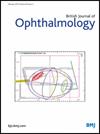Refractive changes and higher-order aberrations after Müller muscle conjunctival resection: a prospective clinical study
IF 3.5
2区 医学
Q1 OPHTHALMOLOGY
引用次数: 0
Abstract
Purpose To evaluate postoperative changes in corneal topographic parameters and higher-order aberrations (HOAs) following Müller muscle-conjunctival resection (MMCR) in patients with mild-to-moderate ptosis. Methods This prospective clinical study included patients who underwent MMCR after a positive phenylephrine test and with good levator function who were evaluated. Preoperative and postoperative best-corrected visual acuity (BCVA), margin reflex distance 1 and corneal parameters (flat meridian, steep meridian, simulated keratometry, maximum keratometry), along with HOAs including coma, trefoil, spherical aberration, secondary astigmatism and quadrifoil, were assessed at week 1, month 1 and month 3. Results A total of 50 eyes from 50 patients were included in the study. BCVA showed mild deterioration at week 1 but returned to baseline by month 3. At postoperative week 1, lagophthalmos was observed in 12% and superficial punctate keratopathy (SPK) in 14% of eyes; both resolved completely by month 1. Eyes with SPK showed significantly greater changes in trefoil compared with those without (p=0.01 and p=0.03 for 4 mm and 6 mm pupil diameters, respectively). A significant difference was found between preoperative and postoperative coma (p=0.04) and secondary astigmatism (p=0.03) values; however, these parameters returned to baseline levels by the third month postoperatively. Surgical success was achieved in 92% of cases. Undercorrection was seen in 6% and overcorrection in 2%, with no functional or cosmetic issues. Conclusion MMCR may cause corneal topographic changes during the early postoperative period. However, these changes appear transient, and MMCR remains a visually safe and refractively stable surgical option for suitable ptosis patients. Data are available upon reasonable request.睫状肌结膜切除术后的屈光变化和高阶像差:一项前瞻性临床研究
目的评价轻度至中度上睑下垂患者行勒肌结膜切除术(MMCR)后角膜形貌参数和高阶像差(HOAs)的变化。方法本前瞻性临床研究纳入了在苯肾上腺素试验阳性和提肌功能良好后接受MMCR的患者,并对其进行评估。在第1周、第1个月和第3个月评估术前和术后最佳矫正视力(BCVA)、边缘反射距离1和角膜参数(平经络、急经络、模拟角膜屈光度、最大角膜屈光度),以及hoa包括昏迷、三叶草、球差、继发性散光和四叶草。结果50例患者共50只眼纳入研究。BCVA在第1周出现轻度恶化,但在第3个月恢复到基线。术后第1周,12%的眼睛出现眼球lagophthalmmos, 14%的眼睛出现浅点状角膜病变(SPK);两个问题在第一个月就完全解决了。有SPK的眼与无SPK的眼相比,三叶叶的变化更大(分别在瞳孔直径为4 mm和6 mm时p=0.01和p=0.03)。术前术后昏迷(p=0.04)、继发性散光(p=0.03)差异有统计学意义;然而,这些参数在术后第三个月恢复到基线水平。手术成功率为92%。6%的患者矫正不足,2%的患者矫正过度,没有功能或外观问题。结论MMCR术后早期可引起角膜地形图改变。然而,这些变化似乎是短暂的,MMCR仍然是一种视觉安全和屈光稳定的手术选择,适合上睑下垂患者。如有合理要求,可提供资料。
本文章由计算机程序翻译,如有差异,请以英文原文为准。
求助全文
约1分钟内获得全文
求助全文
来源期刊
CiteScore
10.30
自引率
2.40%
发文量
213
审稿时长
3-6 weeks
期刊介绍:
The British Journal of Ophthalmology (BJO) is an international peer-reviewed journal for ophthalmologists and visual science specialists. BJO publishes clinical investigations, clinical observations, and clinically relevant laboratory investigations related to ophthalmology. It also provides major reviews and also publishes manuscripts covering regional issues in a global context.

 求助内容:
求助内容: 应助结果提醒方式:
应助结果提醒方式:


